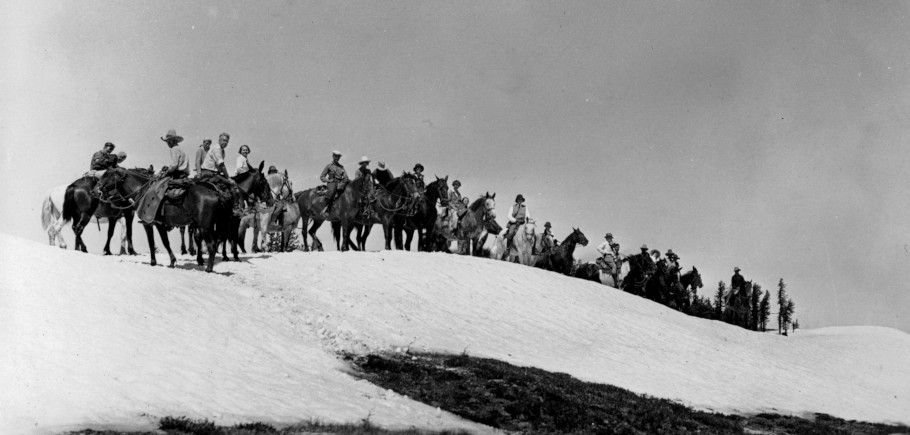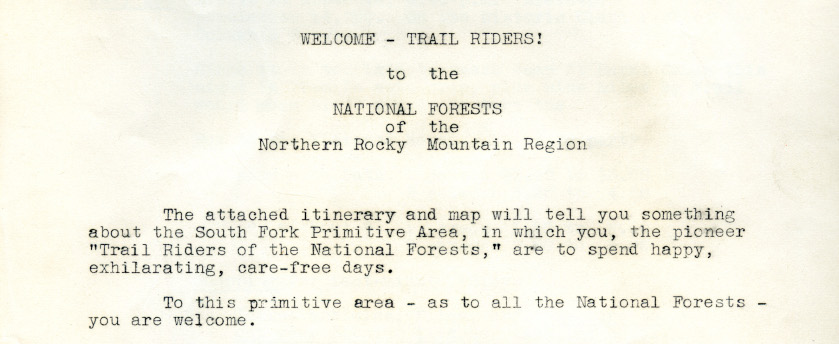Pioneer Trail Riders of the Wilderness
Tweet Share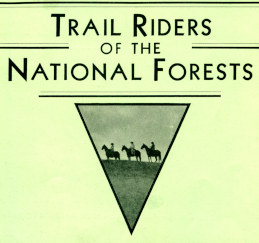 On July 11, 1933, a group of twenty-two men and women headed into the South Fork Primitive Area on Montana’s Flathead National Forest. Members of the party had come from all over the country to experience seven days of horseback travel deep into the rugged wilderness of this recently designated primitive area. The outing was sponsored by the American Forestry Association (AFA) as the “Trail Riders of the National Forests,” and participants were given a first-hand introduction to one of the largest expanses of roadless wilderness in the country. The success of this first expedition would ultimately lead to over 50 years of Trail Riders trips led by the AFA through America’s backcountry.
On July 11, 1933, a group of twenty-two men and women headed into the South Fork Primitive Area on Montana’s Flathead National Forest. Members of the party had come from all over the country to experience seven days of horseback travel deep into the rugged wilderness of this recently designated primitive area. The outing was sponsored by the American Forestry Association (AFA) as the “Trail Riders of the National Forests,” and participants were given a first-hand introduction to one of the largest expanses of roadless wilderness in the country. The success of this first expedition would ultimately lead to over 50 years of Trail Riders trips led by the AFA through America’s backcountry.
This digital exhibit uses materials from the American Forestry Association records to document the experiences of this influential group of inaugural Trail Riders.
Background
The original idea for the Trail Riders program began with Max Goodsill, public relations director of the Northern Pacific Railway, who suggested a sponsored wilderness horseback expedition to Erle Kauffman, editor of the magazine American Forests. Kauffman passed along the idea to AFA Executive Secretary Ovid Butler. Butler fully embraced the idea and immediately began to flesh out plans for the first expedition, even agreeing to personally travel with the inaugural group (scheduling conflicts ultimately prevented Butler from attending). The purpose, from the perspective of the AFA, was not just to host an adventure, but also to provide a first-hand educational introduction to some of the large expanses of untamed wilderness in the American West. The South Fork Primitive Area, a new wilderness area in Montana’s Flathead National Forest, was selected as the site of the first expedition.
In 1929 the Forest Service had enacted the L-20 Regulations, a broad measure designed to protect certain areas within the national forests. Included under this regulation was the ability to designate Primitive Areas that would “maintain primitive conditions of transportation, subsistence, habitation, and environment to the fullest degree compatible with their highest public use.” In 1931, the South Fork Primitive Area was designated within the Flathead National Forest. The nearby Pentagon Primitive Area was established in 1933 and the Sun River Primitive Area in 1934. In 1940 the three were combined and administratively classified by the Forest Service as the Bob Marshall Wilderness, named for the influential forester and wilderness advocate following his untimely death in 1939.
After selecting the South Fork Primitive Area as the location for their first hosted adventure, the AFA—with cooperation from the Forest Service and the Northern Pacific Railway—mapped out a route and announced the trip to the public. The adventure was christened “Trail Riders of the National Forests” (renamed Trail Riders of the Wilderness a few years later). The Forest Service’s direct cooperation allowed the AFA to offer unique wilderness experiences alongside the forest rangers who worked to protect those same lands. The plan was to have Forest Service rangers meet with the Trail Riders at the start of each trip to explain their role in managing the lands and introduce the group to the region they were about to explore. The first trip was scheduled for South Fork in July of 1933, with a second trip to follow in August through the Sun Wilderness of the Lewis and Clark National Forest. Now they just needed participants. The Trail Riders adventure was first announced to AFA members in the pages of American Forests in February 1933: “The American Forestry Association invites lovers of the out-of-doors to join the ‘Trail Riders of the National Forests’ and ride beyond the outposts of civilization during July and August into the wild, untamed back country of Montana.” The AFA continued to promote the trip in the magazine and with informational brochures in the months to follow, beckoning prospective travelers to join them with colorful, descriptive language:
“Six days of wonderment, of marvel, of undreamed-of beauty! Nature unchanged for centuries. Mountains that lose their peaks in the clouds, canyons that sink out of sight, virgin forests that unfold as the sea, cold snow water forming hundreds of unknown lakes in glacier basins, wild life in all its unspoiled beauty. These are some of the secrets of the South Fork Wilderness that await the Trail Riders.”
Travel Party
Twenty-two men and women signed up for the inaugural Trail Ride. Each registered with the AFA, paid their $43.75 fee, and made plans to travel to Montana in early July. Although the trip had an ambitious itinerary of riding 7 to 18 miles per day, minimal rest time, and back country camping under the stars, the AFA nonetheless stressed that it was designed for amateurs and that “one need not be experienced in the saddle or have knowledge of trail life to make the trips.” The men and women who ultimately signed up represented a diverse range of backgrounds. The group, hailing from cities and towns throughout the country, would meet at the Florence Hotel in Missoula on July 10th. The trip’s final roster included:
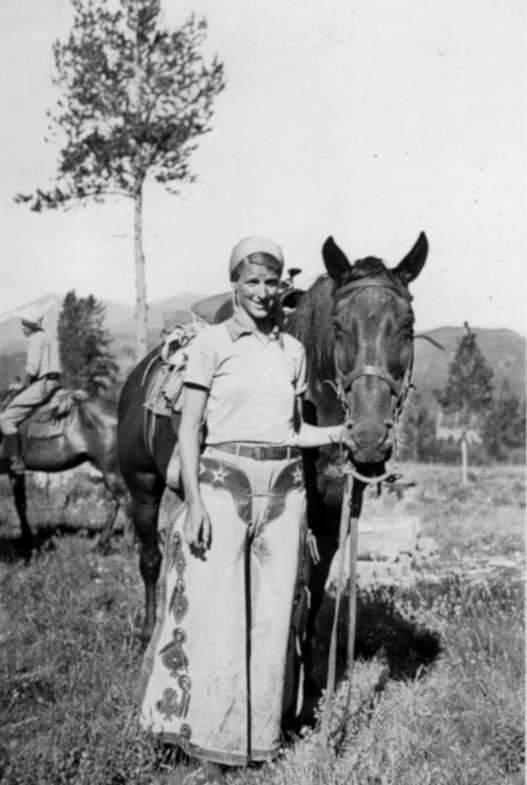
Grace Jones, one of three Trail Riders from Moorestown, New Jersey.
- Fred E. Hornaday, business manager for the American Forestry Association.
- R.F. Hammatt, Assistant Regional Forester, and in charge of public relations for U.S. Forest Service Region 1.
- Maurice Thompson, representing the Tourist Office of the Northern Pacific Railway Company.
- B. L. Brown, Official Photographer of the Northern Pacific Railway Company.
- Mr. and Mrs. William Alderton, a professor and high school teacher from Chicago, along with their nephew Edward Winsor of Oakland, California.
- Dr. Walter G. Becker, of Johns Hopkins University in Baltimore.
- Loretta Bothe and Angela Janszen, stenographers from Cincinnati, Ohio.
- Margaret Jones and her younger sister Grace Jones, along with Nancy Page, all from Moorestown, New Jersey.
- Alice and Harriet Pierce, Spanish teachers from New York City.
- Mary Ruffner and Virginia Barney, probation officers from Denver, Colorado.
- Marian Simmons, a nurse at the Portsmouth, New Hampshire, Veterans Hospital.
- A. H. Hutchinson, Chicago businessman, and his son Dick, along with family friend Bill Tracy.
- Carmen Haider of New York City, originally from Germany and a personal friend of Bob Marshall.
Traveling along with the group above were seven more in the packing outfit, led by guide Joe Murphy. This made a complete party of 29, along with 55 head of stock (view the original traveler’s register signed by all members of the party).
The Journey
The route would take the group through remote mountains and valleys in northwest Montana, just west of the Continental Divide. The group would traverse the peaks of the Holland and Swan Ranges, travel through the green valleys surrounding Big Salmon Lake, and ride alongside the many pristine lakes and rivers throughout the area. The map below details the exact route, along with markings for each night’s camp.
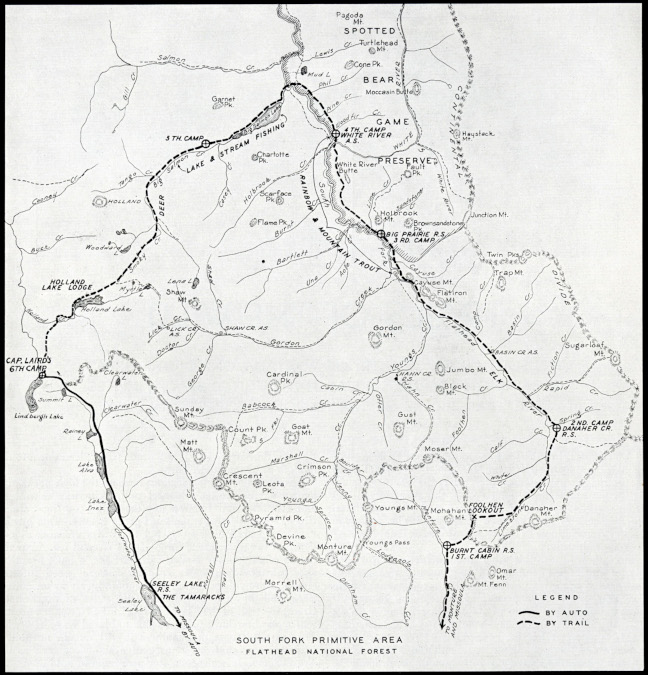
Route map of the inaugural Trail Riders trip through the South Fork Primitive Area (click to enlarge).
The first members of the group began gathering in Missoula on July 9th, and the trip began early in the morning of July 11th. The uncorrected text that follows is the official day-by-day report of the trip written by Fred Hornaday for the AFA’s official records (view original), covering the group’s experiences from July 9 to July 17, 1933.
July 9
Upon arrival at Missoula, Montana, on the North Coast Ltd., at 3:40 pm, July 9, I was met by R.B. Stevens the Northern Pacific Representative and R.F. Hammatt, Assistant Regional Forester, in Charge of Public Relations, Region No. 1. The three of us discussed final details of the trip at the Florence Hotel that night. Already on hand were Dr. Walter G. Becker, of Baltimore, Maryland, Miss Mary Ruffner and Virginia Barney of Denver, Colorado, Miss Margaret and Grace Jones and Nancy Page, of Moorestown, New Jersey, as well as Miss Marian Simmons of Portsmouth, New Hampshire, who had arrived several days earlier for a Dude Ranch visit in order to accustom herself to the Western saddles.

Fred Hornaday.
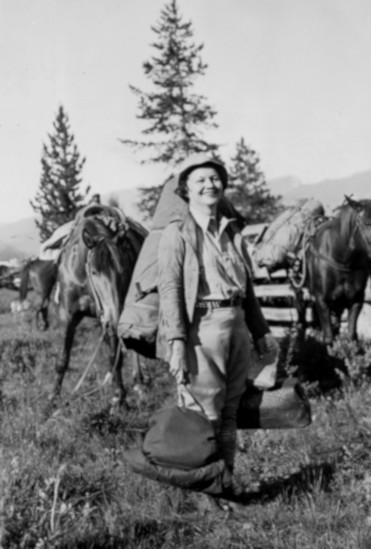
Marion Simmons
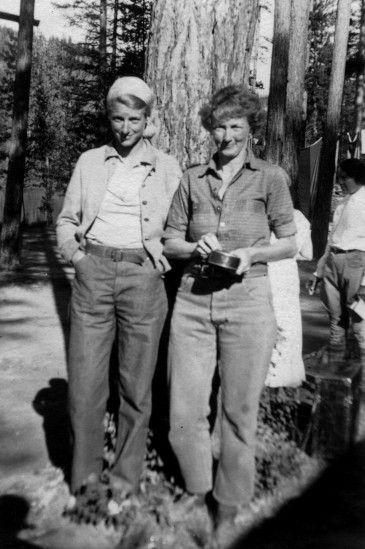
Grace Jones and Margaret Jones.
July 10
Others were contacted as they arrived in Missoula either by train or automobile and a meeting was called at the Florence Hotel immediately after the 3:40 train on July 10. The last of the party had arrived by this time, and the Trail Riders were informed that the trip instead of starting that afternoon would start at 8:45 am the next day. This was desirable due to the distance to our first night’s camp at Burned Cabin. Everyone approved, for they were rather tired from travel, although some expressed disappointment because of their eagerness to get away.

The Trail Riders gather outside the Florence Hotel in downtown Missoula, Montana.
At this meeting I welcomed the Trail Riders in the name of the Association, informed them of the purpose of the trip, namely to secure a greater appreciation on the part of the public for the few remaining wilderness areas in the country, and assured them that the Association would do its utmost in making the trip an outstanding success and a pleasure to all. Mr. Hammatt welcomed the group in the name of the U.S. Forest Service and gave each person a mimeographed list of instructions together with a map of the country to be traversed. Mr. Stevens demonstrated the correct method of using the approved sleeping bags.
At 7 pm the Missoula Chamber of Commerce provided automobiles so that our party might visit the University of Montana and the C.C.C. Camp at Fort Missoula. Later in the evening Bill Hill, Game Warden, was on hand to sell fishing licenses at $3.50, and a local character, “Paul Bunyan” was on hand to sell flys. Bill Hill entertained our entire party with his wild stories of how he personally had run the Indians out of that country when a boy, and he built up a very dramatic picture of the country we were to see.
July 11
Everyone was up early and ready to leave on the Intermountain Co. Bus at 8:45. After a scenic ride along the last road we were to see for almost a week, we arrived at Monture Ranger Station at noon, where we were met by Joe Murphy, our guide and packer, and where we had our first sight of the 55 horses and mules which were to make up our party. Joe Murphy’s outfit consisted of seven, including Joe Murphy, his son, Bill the Cook, Whitey the Assistant Cook, and three wranglers.
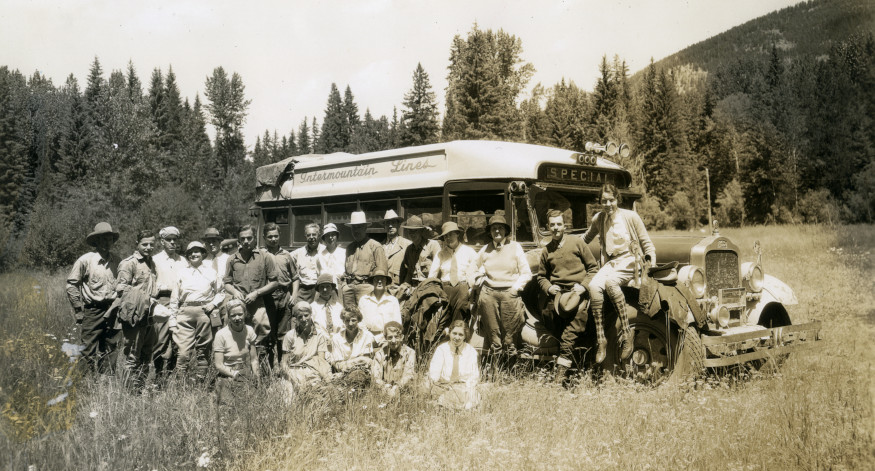
We had lunch of ham sandwiches, hot dogs, cheese, coffee, doughnuts, cakes, etc., picked out our own horses, adjusted the stirrups and were on our way at 2 o’clock for the big adventure. In our eagerness to be on, the horses walked and trotted the nine miles to Burned Cabin Ranger Station where we arrived at 5 for our first night’s camp. Our pack outfit got a late start and didn’t arrive till after 7:30, but dinner was enjoyed an hour later.
Our ride today was through country much of which had been burned over. We were beginning to see the importance of recreation in this region, for much of the commercial value of the timber has been lost. After the hot ride today, we could not wait for our bathing suits which were on the pack train, so two separate swimming camps were established for our first dip in a cold mountain stream. Our first mishap occurred when Miss Haider fell off a log and went into the stream with her clothes on. W.K. Samsel, Ranger, was our host at Burned Cabin. Around the camp fire that evening we all discussed the climb which was to face us the next day to the top of Foolhen Lookout, 8,600 feet.

The first day’s ride ends with arrival at Burned Cabin Ranger Station.
July 12
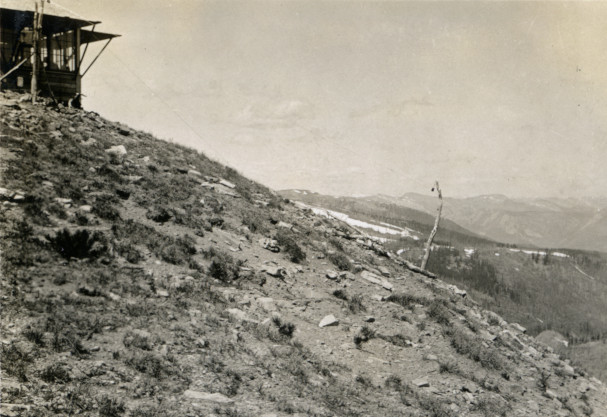
Foolhen Lookout, 8,600 ft. with Continental Divide in background.
Bright and early, one of the wranglers cut his finger, and after showing her ability as a doctor, Miss Haider was appointed official first aid helper. We were up at 6 this morning for a 6:30 breakfast of eggs, bacon, sausage, pancakes, etc. This first morning most of the party was disturbed by the wrangling of horses at 4:30, but we were soon able to get used to this. Miss Haider and Dr. Becker seemed to make a good pair for they are both German and have many mutual acquaintances. We packed our own lunch today and carried it with us for we were to go ahead of the pack train. It is about this time that we learn that Miss Haider had taken an early morning swim at 5 o’clock, and she continued to do this on the rest of the trip.
After a long climb through burned country, we reached Foolhen Lookout at 8,600 feet. Here we obtained a magnificent view of the Continental Divide and in the distance of the peaks which make up Glacier National Park. Our pack lunch was enjoyed at the lookout tower and afterwards most of us participated in a snow ball battle. Much of the climb this morning was through huge snow drifts. This was quite a sensation for most of the party and it was an interesting sight to see mountain wild flowers peeping their heads up through the snow.
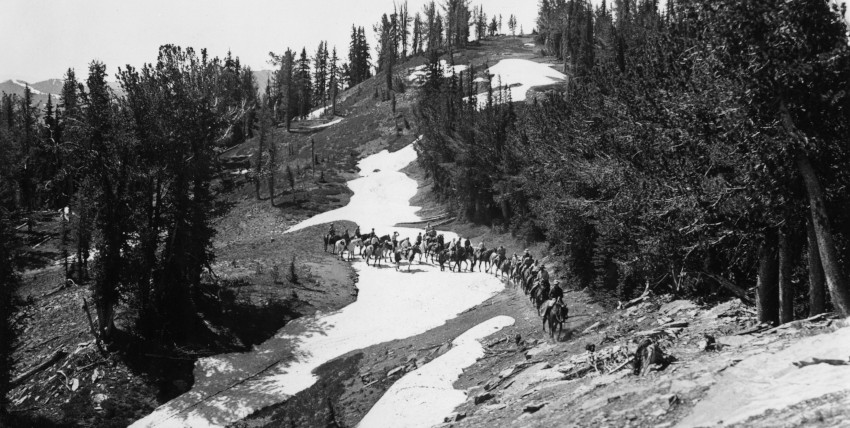
Riding across the snow near the summit of Foolhen Mountain.
Off again and on the down grade to reach Danaher Ranger Station at 4:45. Our trip today was of 18 miles and our horses had their first opportunity for cantering. This afternoon we saw our first deer and several foolhens. A good dinner at 6:30 of hamburger, beans, potatoes, bacon, peaches, coffee, etc. Dr. Becker has found the mountain air too cold so we secured additional blankets from Ranger Sousley which are to be returned at the end of the trip. Sousley tells us we are the first party to come in this year, and until late that night we listened to his interesting stories around the camp fire. He tells us that the Flathead Forest in which we are now located has something like 1,000 elk and that about 180 have starved during the past winter for lack of food. Every day of our trip we see their bones along the trail.
July 13
Horses are all saddled and we have breakfast at 6. This morning our sleeping bags are covered with a sheet of frost. No one now complains of lack of sleep. Miss Haider surprised everyone, even the cowboys, when she started off for the creek in her bathing suit at 6 am. Her way through the brush was rough and some were fearful that she would be scratched getting down to the river and back, but as Joe Murphy our guide said, “Those Kind don’t scratch.” Yesterday was a hard day and today will be harder for we have close to 20 miles to go by the South Fork of the Flathead River to Big Prairie Ranger Station, so we split up into two parties, the first one leaving at 8 and the second at 8:45. Our second party was forced to go 14 miles before we reached water for lunch at 2 pm. This made a short afternoon ride to our camp at the Big Prairie Ranger Station. Through every mile of this trip so far we have seen marvelous examples of mountain wild flowers including lupin, paint brush, sago lily, harebell, trailing arbutus, galardias, clematis, columbine, penstamen, forget-me-nots, wild flax, bear grass, wild geranium, wild rose, marigold, wild holly-hock, and yellow and purple heather. The prevalent timber is lodgepole pine in the flats and Douglas fir in the high country.
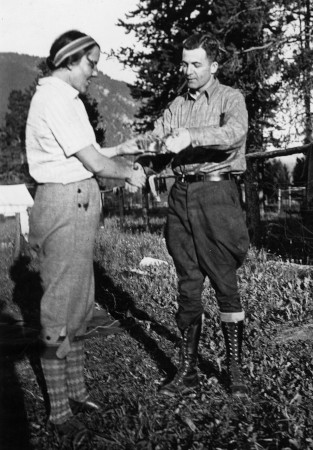
Angela Janszen presented with cup at Big Prairie Ranger Station.
The grind has begun to tell on the two Pierce sisters who seem to be well past 55 years of age. Mr. Hammatt and I were forced to stop a while this afternoon to enable Miss Alice Pierce to rest a bit and she found it more desirable to walk the last mile into camp. The first party reached Big Prairie Ranger Station at 1:30, the second at 4. We are all impressed with the wonderful hospitality of Ranger Sousley for he permits us to camp within the Station grounds as well as offering us bunks within the cabins for those who desire them. We accept two for the Pierce sisters but the rest of our party prefer to sleep under the stars. Here we received our first messages for the outside world. Telegrams from Mr. Pratt, President of the Association, as well as from Mr. Stevens of the N.P. Railroad. Everyone appreciates the sentiment of Mr. Pratt’s telegram, and we quickly realize how fortunate we are to have a glimpse of this country which, except for a few trails, has been unchanged since created by God.
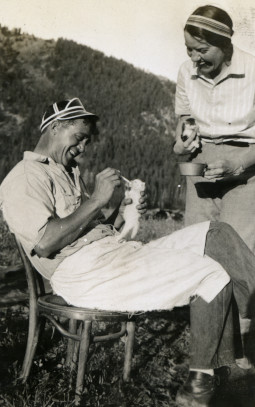
Cook at Big Prairie Ranger Station, feeding kittens with help from Angela Janszen.
We have in our party a professional walker in Miss Angela Janszen. For exercise she paces down the airplane landing field 2,400 feet, in 5 1/2 minutes, and facing a battery of “News photographers” she is presented a tin loving cup by Mr. Hornaday. Our party found much enjoyment in watching Scoop, the Station Cook, feed two three week old kittens, O’Brien and Lindy, with a medicine dropper. This was our most interesting night around the camp fire with one of the smoke chasers singing song after song to the accompaniment of his guitar, and before long we had all successfully joined in the refrain,
“Home, home on the range,
Where the deer and the antelope play,
Where seldom is heard
A discouraging word,
And the skies are not cloudy all day.”
The camp fires are an interesting feature of our trip, for to most of us the large camp fires which we enjoy are an unusual sight.
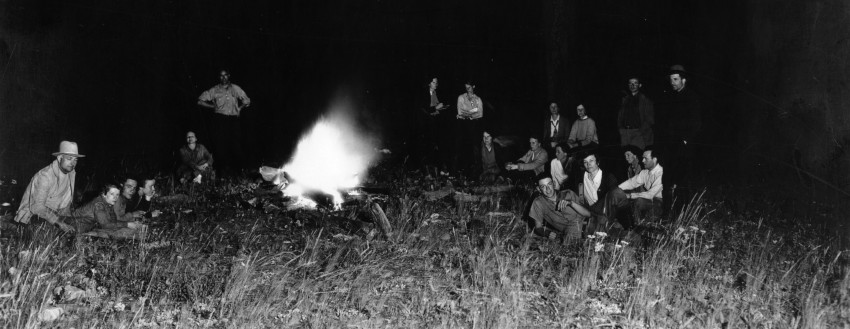
July 14
Breakfast at 6:30, off again at 8, where we arrived at Joe Murphy’s cabins at White River at 10:30. This was just a seven mile jaunt, but the entire party was delighted to have this entire day for rest and recreation, some swimming, some fishing for trout and others confining themselves more closely to camp.
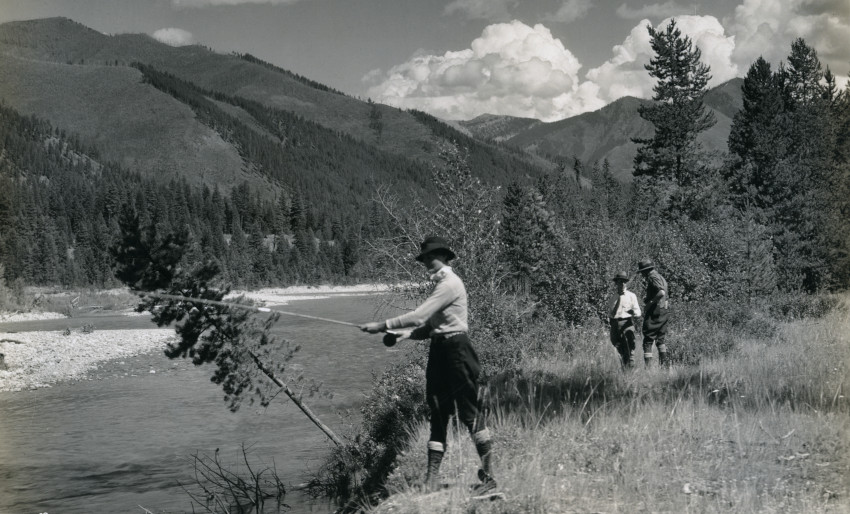
Mary Ruffner fishing for trout in the South Fork.
A dozen or so deer and elk were seen on the ride this morning. Brown, the Northern Pacific photographer, has been constantly taking stills and moving pictures of our trip and plans to take about 15 hundred feet of film before he is through.
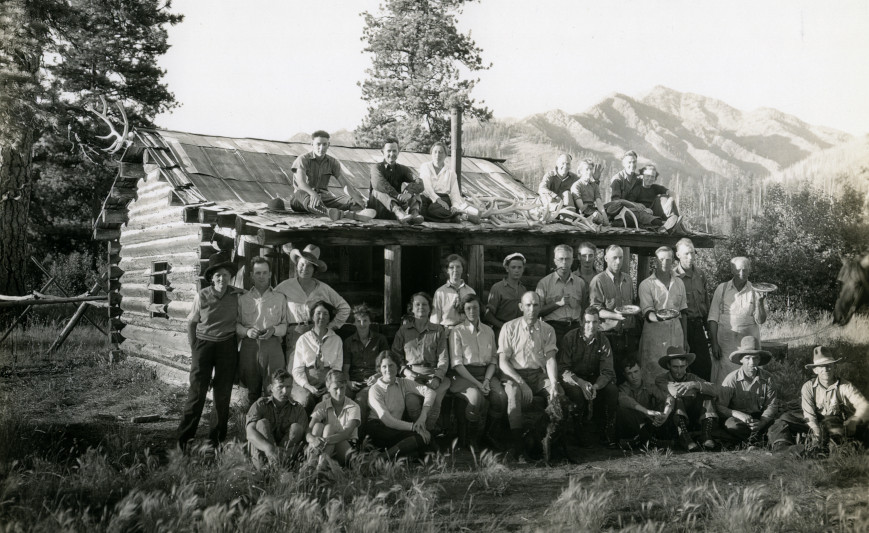
Photo by B.L. Brown of the group at one of Joe Murphy’s cabins on Holbrook Creek, with Swan Range in background.
Today is the birthday of Nancy Page of Moorestown, New Jersey, so Bill our Cook has agreed to make 15 cherry pies and a birthday cake. This birthday party was a feature of our trip long to be remembered. It is remarkable how much enjoyment we can secure out of a birthday dinner served from tin plates, tin cups and tin cans.
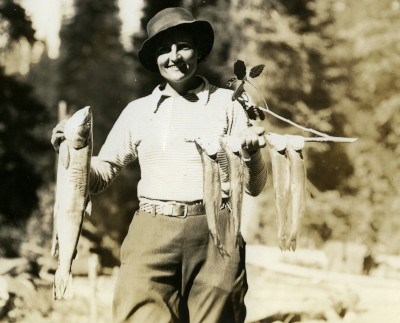
Showing a few trout caught in Big Salmon Lake.
July 15
Up at 6 with breakfast at 6:30 and off again at 8 where we arrived for lunch at the Head of Big Salmon Lake. Our trip skirted five miles of this beautiful lake and after lunch our party enjoyed its best fishing. Miss Janszen has been named the official collector of the party. She is now carrying a piece of elk horn, a tooth, a piece of elk hide and a horse shoe. In order to make our last day shorter, we carried on past our proposed Big Slide camp to a wilderness camp at Tango Creek, where we arrived at 5. Big Salmon Lake was the outstanding body of water seen on our trip. It is estimated that less than 500 people see this beautiful sight each year, and it is such beauty spots which the party hopes will be preserved as wilderness areas.

Janszen and Bothe in sleeping bags.
July 16
Hammatt and I were awakened this morning by three porcupines coming into camp for food. Whitey, our Assistant Cook, killed two of them but the third scampered away. Today we are facing one of the hardest days, but everyone is sorry the trip is about over. During the morning we climbed Holland Peak to the summit which is close to 10,000 feet, then through Gordon Pass out to the most spectacular view of the entire trip, a sheer drop down the mountain side with a marvelous view of Holland and Lindbergh Lakes. Many of our party walked this afternoon for the first time, but an equal number stuck to the horses for the sharp descent down a zig zag trail of 4,000 feet in four miles. This was by far the worst trail we had experienced and as Captain Laird later told us, “It is so tough that even an eagle would lose its liver flying down.” At 4 pm we reached the end of the trail where we bid goodbye to Joe Murphy and his party. We were picked up by the same bus which had brought us into the region and taken to Captain Laird’s Recreation Lodge on Lindbergh Lake, where we enjoyed a fine supper and good beds.

Dining room at Captain Laird’s Recreation Lodge on Lindbergh Lake.
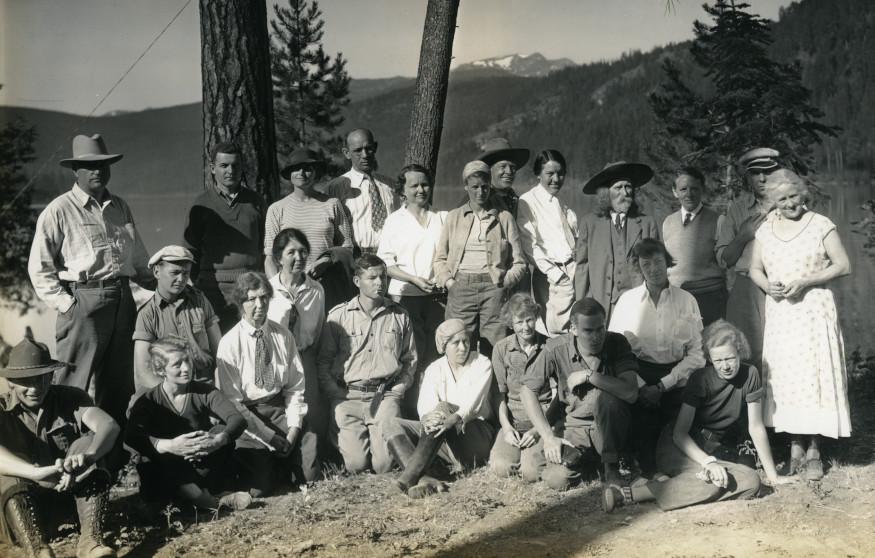
Trail Riders at Captain Laird’s Recreation Lodge, with the Lairds and Mr. Garcia.
July 17
Nine o’clock this morning we started on the return trip to Missoula with a delightful luncheon stop at the Tamarack’s on Seeley Lake.
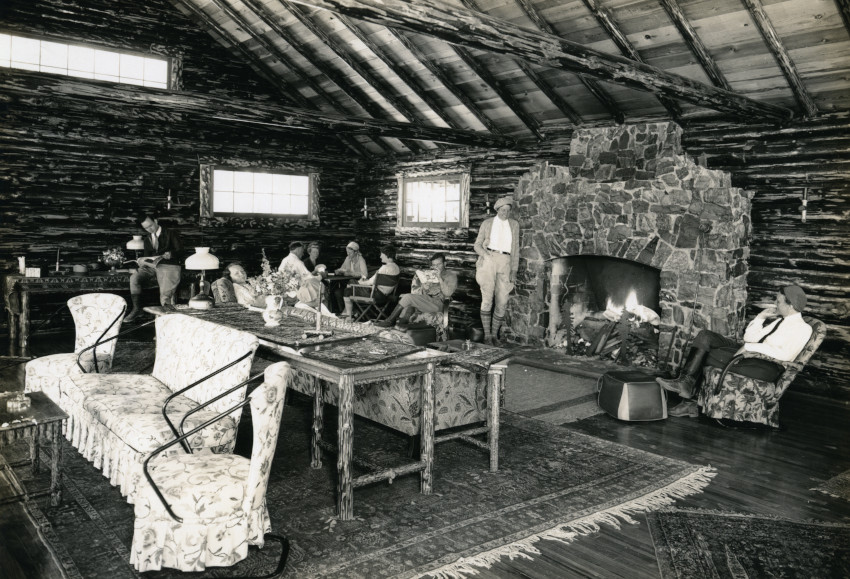
Trail Riders at the Recreation Lodge at “The Tamaracks” on Seeley Lake.
We reached Missoula 30 minutes ahead of the departure of the North Coast Limited East. The bulk of our party took this train, others leaving by automobile later in the afternoon. At the suggestion of some of the members of the trip, the attached telegram was dispatched to the headquarters of the American Forestry Association.
We have the highest praise for the stamina of everyone taking the trip. At the start, opinion was divided as to the hardships which might be encountered. Some expected an easy trip, others expected it to be difficult. It turned out to be hard going all the way, but every single person was proud of the fact that they came through in such good shape, and everyone would like to turn around and start over again. The stock used was especially good, all of the horses sure-footed, and only two minor mishaps occurred. Mr. Alderton and Dr. Becker both had accidental falls from their horses.

The women of the Trail Riders in the Swan Mountains.
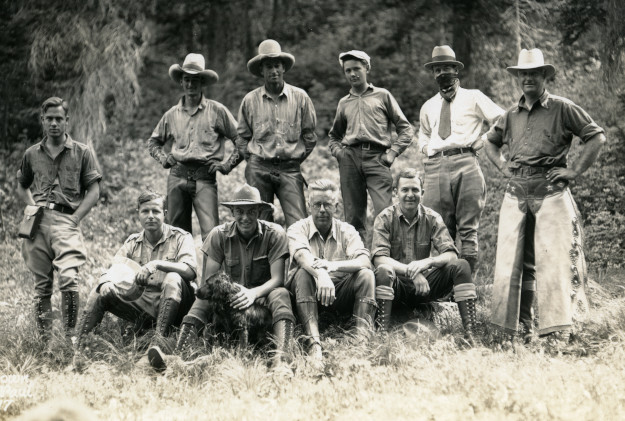
The men of the Trail Riders party in the Swan Mountains.
Photographs
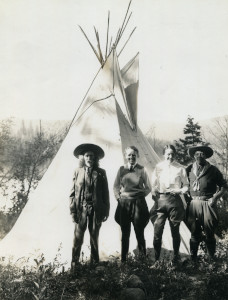 Mr. Garcia, Miss Bothe, Miss Janzsen, and Captain Laird. |
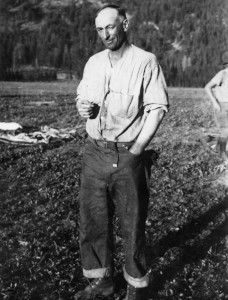 Joe Murphy, the group’s guide and host, at Big Prairie landing field. |
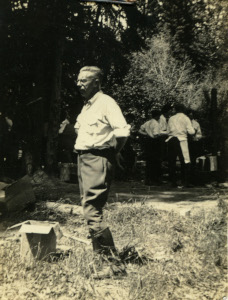 R.F. Hammatt, Assistant Regional Forester, U.S. Forest Service. |
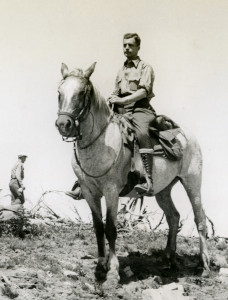 Fred Hornaday on “Nellie” at Foolhen Lookout. |
Browse the Complete 1933 AFA Trail Riders Image Gallery
Additional Resources
Angela Janszen wrote her own account of the inaugural Trail Ride entitled “My Dream Come True.” Janszen wrote: “For years I have dreamed of ‘roughing it’ in the mountains of the northwest, sleeping under the stars, eating beside a thundering stream—living as did the pioneers. The Trail Riders of the National Forests took us into the wilderness of the Southfork Primitive Area in the Flathead National Forest and made my dream come true.”
A few months after the Trail Ride, Janszen got a temporary job with the U.S. Forest Service. This would lead to a Forest Service career which would take her from Washington, D.C., to a remote logging camp in Alaska, and various points in between. After marriage she became Angela Janszen Burke, but later in life would be known as the “Smokey Bear Lady,” due to her frequent visits to schools giving programs on fire prevention and forest conservation. In 1975, the Forest Service presented Angela Janszen Burke the “Smokey’s Friend” award for her many years of service.
In September 1933, American Forests published an illustrated account of the inaugural adventure: “The Pioneer Trail Riders: First Trip of the ‘Trail Riders of the National Forests’ Great Success.” The article included quotes from many of the participants, such as Mary Ruffner, who stated: “Everyone benefited immensely from this outing both in spirit and body, and when I remember the ruddy and healthful appearance of us all as we regretfully said goodbye, I really fervently hope that these trips may be indefinitely extended to many other people who have forgotten or who have never known the invigorating charm of the wilderness.”
Richard F. Hammatt of the U.S. Forest Service published his own account of the trip in the January 1934 issue of Western Wildlife magazine.
Film footage shot by K.D. Swan of the July 1935 Trail Ride to the Flathead and Sun River Wilderness in Montana is available via YouTube and the Internet Archive.
The inaugural trip (along with the second trip in August 1933) proved so successful that the American Forestry Association (later renamed American Forests) put on the Trail Riders program for the next 50 years. T. Edward Nickens looked back at the 50-year history of the Trail Riders program in the Summer 2000 issue of American Forests with the article, “Trail Riders of the Wilderness.” Nickens discusses how after 50 years the Trail Riders program ultimately became a victim of its own success: “The Trail Riders program ran strong through the early 1980s, adding covered wagon trips, canoe adventures through the Boundary Waters of Minnesota, and Alaskan sea kayaking trips to its program offerings. But a changing wilderness ethic began to cause concerns as more and more people trekked to backcountry regions during the explosion of interest in backpacking and wilderness travel. The Trail Riders operated under American Forests’ guidelines to lessen environmental impacts…but the potential for ecological damage to fragile mountain meadows and popular camping sites was real, especially with larger groups…Having helped usher in the environmental and ecotourism movements, with thousands of participants turned on to wilderness preservation, the program suffered under changing perceptions of what was appropriate in the nation’s remaining wild regions.” The Trail Riders program ended in 1988. The decision to end it is a testament to the organization’s long-standing philosophy of promoting the ecological health of forests for all.
